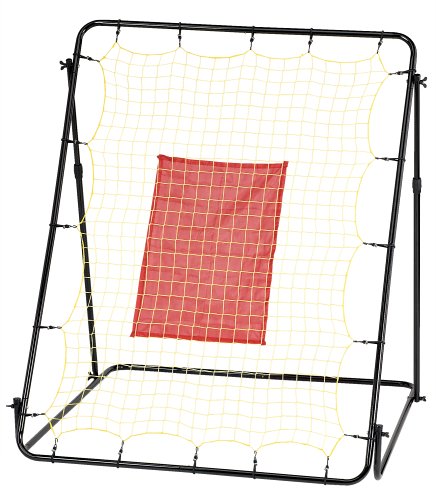 Want to improve your throwing and catching? Spalding's 15175 Multi-sport Return Throw System can help you to get better because it's ready to practice whenever you are. This multi-sport return throw system is 59-inches tall and 44-inches wide, with a one-inch, welded steel frame. This return throw features adjustable, steel-frame legs that allow multiple angles of return, so you can practice catching fly balls, grounders, and everything in between. The all-weather, nylon net is secularly attached by bungee cords, assuring a superior return, and it features an adjustable strike zone. The return throw also comes with four ground stakes for added stability and even folds up for easy storage.
Want to improve your throwing and catching? Spalding's 15175 Multi-sport Return Throw System can help you to get better because it's ready to practice whenever you are. This multi-sport return throw system is 59-inches tall and 44-inches wide, with a one-inch, welded steel frame. This return throw features adjustable, steel-frame legs that allow multiple angles of return, so you can practice catching fly balls, grounders, and everything in between. The all-weather, nylon net is secularly attached by bungee cords, assuring a superior return, and it features an adjustable strike zone. The return throw also comes with four ground stakes for added stability and even folds up for easy storage.
Customer Review: Very Happy With This Product
I haven't used one of these ball returns since I was a kid, but I wanted my 7-year-old son to have an opportunity to practice like I use to. I was hesitant about ordering this, because surely it couldn't be as good as the one I use to have. Boy, was I wrong. This is a great ball return and is quite sturdy. Be prepared for the dreaded "some assembly required." The directions are far from good, and I eventually resorted to using the picture on the box for reference. But after it was assembled, it became fun to use and we look forward to many practice days ahead. I would highly recommend this.
Customer Review: Great for young aspiring athletes!
I purchased this for my grandson who is 5-1/2 and loves playing T-ball. It has helped him learn to be ready when the ball comes back to him to catch and he can play by himself without having someone else throw the ball to him. It is very sturdy and easily assembled.
If you a contemplating coaching little league baseball or you are already involved it is always good to step back and review your program and decide if you are still on track. I always remind myself that i am here for the players, after all this is all the the kids not the adults!
It is good to decide why you are coaching little league baseball or why you want to? In order to be successful in little league baseball a coach must have a plan and stick to that plan. Practices need to organized with the idea of keeping it snappy and interesting for the players. how do you do this??
Don't stay to long on the same drill! I can't stress this enough. Coaches always want to see there players perform a certain drill to perfection, that's great but if you stay on the drill too long players lose interest. I'm helping a guy who is the manager of a Major boys little league baseball team that my son was just drafted onto.
Just the other night we were doing a drill were 2 coaches hit balls at shortstop and 2nd base. This is a great drill however i felt like we stayed too long with it because the kids couldn't get to 10 in a row with out throwing the ball away or making a fielding error! You can always tell when they loose their focus. it should be 10 minutes no longer and then you say to them that will come back to that the next practice.
In order to get the most out of your players you have to keep in mind that they are young and to keep it fun and keep moving through the drills.
Another point to focus on is covering things that will happen in a game situation. Are you stressing things that will happen most of the time. Force outs, where to throw the ball from outfield in certain situations. Stress to your young players to always ask themselves if the ball comes to me what am I going to do with it??
Don't waste time on a situation that is not likely to come up very often. Remember we Don;t have a lot of time so make the most of it!
Getting back to a organized practice, always talk to your players just before practice starts about what they are going to learn today! Once practice is over go over what you worked on and then ask them what they learned. Coaches, remember long after the game is over players will remember how they were treated not what the score was.
For more information contact me at 406-542-1723
Stephen K Reynolds is publisher of the LSR Unlimted "Free" newsletter which focuses on helping newcomers & seasoned pros learn the secrets to marketing in the ever changing world of the internet! He also is a coach in youth baseball in Montana. working on the Internet allows him the freedom to coach little league baseball. For more information on this e-mail lsrwealth@gmail.com
(800)758-1282
406-542-1723
http://www.urticket.org